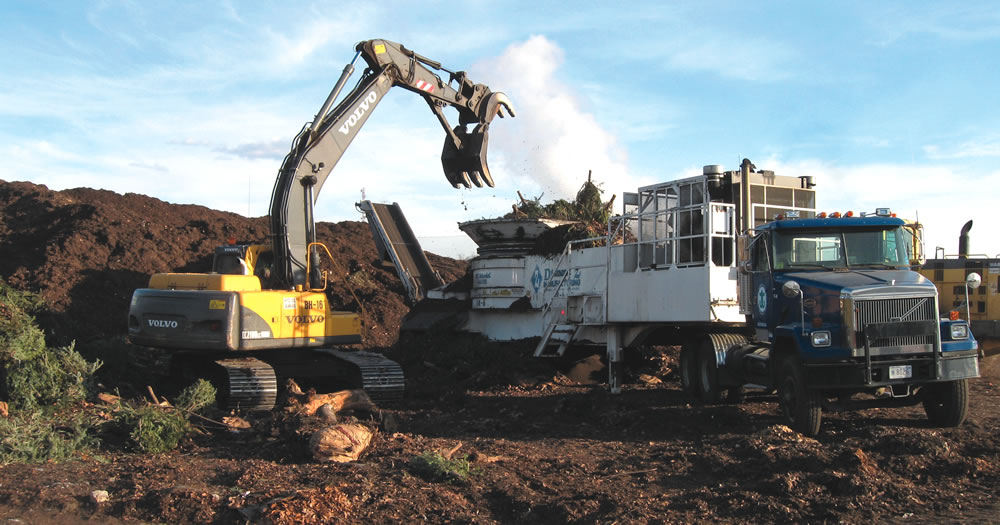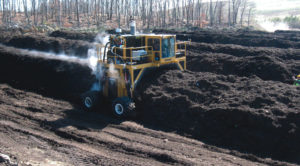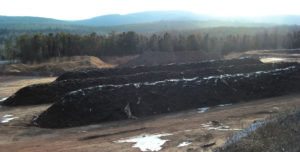The Rhode Island Resource Recovery Corporation changed its management approach to increase throughput and make a high quality product.

In Rhode Island, major waste management functions have historically been vested in two agencies: the Rhode Island Resource Recovery Corporation (RIRRC) and the state’s Department of Environmental Management (RIDEM). RIRRC is the state’s quasi-public agency responsible for providing the public with environmentally sound programs and facilities to manage solid waste, including Rhode Island’s recycling program. It owns and operates the Central Landfill and Materials Recycling Facility in Johnston.
As early as 1995, RIRRC began a program to receive and process leaves and yard trimmings from most of the cities and towns in Rhode Island. Many municipalities did not have a site to properly manage the material and RIRRC, being centrally located, was a regional option. Incoming material must be 2-inches in diameter or less to be accepted. It consists mainly of leaves, grass clippings, brush and other minor yard debris. Since 2005, RIRRC has averaged about 39,000 tons a year of material.
All inbound organics are processed using a Diamond Z 1463B tub grinder to reduce particle size and provide an initial mixing of material. Originally, ground yard trimmings were composted in static piles and windrows. Materials handling and turning were done using a front-end loader and grapples. It would take an operator a day to turn each windrow. Because of manpower and equipment issues, some rows would not be turned for months, thereby lengthening the decomposition process and causing more and more of a backlog in the entire operation. The net effect was RIRRC typically ran out of room to properly grind material and form windrows. Each windrow took approximately 8 to 11 months to break down.
In 2001, RIRRC began using a catalyst from an outside vendor to expedite the composting process, when seasonal high volumes of leaves and yard trimmings were received during the early spring and late fall. Use of the catalyst continued into 2007 when, under new management, RIRRC questioned the ability of this product to actually accelerate the composting process. In addition, the product was very costly and did not appear to produce a high quality product. In 2008, a pilot study with side-by-side windrows, one treated with the catalyst and the other not treated, failed to show much difference in the time it took the windrows to cure. In 2008, RIRRC eliminated use of the catalyst and revised its RIDEM permit to have windrows decompose naturally.
Historically, the finished compost was used as cover on the slopes of the landfill because it was classified by RIDEM as “Class C” compost, which had use limitations. In 2007-2008, RIRRC realized that the amount of compost being used in the landfill operation was “wasting” valuable airspace and that the composting operation, if managed correctly, would create a commodity that could be sold to gain some revenue. Also, due to the volumes of leaves and yard trimmings being received by RIRRC (at no charge to the municipalities), the agency needed ways to make the process more efficient and cost-effective.
Shift to “Product” Mindset
The concept of treating this material as a product took hold in 2008. Since then, changes in the overall process have taken place from start to finish. For example, RIRRC began screening its compost to produce a maximum three-eighth inch product (particle size
The product was reclassified as a RIDEM Class “A” material, which has unlimited uses. A portion of the compost is used onsite for operational purposes, taken back by municipalities and sold to residents. The remainder is marketed through a third party (previously Agresource, Inc. and now New England Organics), which sells the compost for diverse applications such as turf farming, sports field construction, wetlands restoration and roof gardens.
In 2011, RIRRC recognized that to keep up with the high volumes coming to the site, it needed to process material more quickly. In April 2011, during discussions with a representative from Woods End Laboratory, it was suggested that RIRRC use a windrow turner to speed up turning and curing of each windrow, and perform Solvita testing to verify stability. In June 2011, RIRRC tested several turners on a trial basis, and is now renting a Vermeer Model CT718 unit. A bid to purchase a turner is being released in January 2012.
 Benefits from using the turner have been measurable. With the loader, RIRRC was turning approximately 200 to 250 cy/hour. With the windrow turner, RIRRC can turn approximately 3,000 cy/hour, reducing the overall cost of the composting operation and better utilizing manpower. The compost pad is constructed on gravel and when using the loader to turn windrows, the pad would have ruts from the tires, creating small areas of standing water after rain events. With the turner, the pad is continuously flat and foreign materials such as dirt, rocks, etc., from the underlying pad are not introduced into the windrow.
Benefits from using the turner have been measurable. With the loader, RIRRC was turning approximately 200 to 250 cy/hour. With the windrow turner, RIRRC can turn approximately 3,000 cy/hour, reducing the overall cost of the composting operation and better utilizing manpower. The compost pad is constructed on gravel and when using the loader to turn windrows, the pad would have ruts from the tires, creating small areas of standing water after rain events. With the turner, the pad is continuously flat and foreign materials such as dirt, rocks, etc., from the underlying pad are not introduced into the windrow.
Daily record keeping of weather conditions (wind direction, ambient air temperature), odor (if detected), dust, vector and litter issues, condition of the compost pad, windrow monitoring and corrective actions needed and taken is performed by the site operator. Windrow temperatures and moisture are measured using a ReoTemp thermometer and a moisture meter. Data that once took many man-hours to enter into a spreadsheet manually is now entered into a Workabout Pro3 M/C hand held computer. This unit syncs data and produces a report and graph automatically. This process has reduced record keeping time by 40 percent.
Both management systems (hand held computer and Solvita) generate a spreadsheet showing the windrow’s conditions. This information has made communication between RIRRC personnel involved with the composting operation more efficient. The spreadsheets, along with a site plan showing when windrows are turned and measured for stability, volume and space, are sent to the RIRRC Director of Engineering and Operations and the Landfill Operations Supervisor, in order for them to better schedule crews to work on composting.
 To get a more precise assessment from the Solvita test, RIRRC purchased a Digital Color Reader (DCR) to eliminate the subjectivity of color discrimination and notably improve the scale of readability. Using the maturity test provides a better method and rapid interpretation of determining when a windrow is cured and when it can be moved off the pad for screening. Previously, RIRRC would determine when windrows were complete based on a visual inspection and when the temperature readings continued to decrease even after being turned. New England Organics uses the Solvita test results to confirm that the compost is stable and ready for sale to customers.
To get a more precise assessment from the Solvita test, RIRRC purchased a Digital Color Reader (DCR) to eliminate the subjectivity of color discrimination and notably improve the scale of readability. Using the maturity test provides a better method and rapid interpretation of determining when a windrow is cured and when it can be moved off the pad for screening. Previously, RIRRC would determine when windrows were complete based on a visual inspection and when the temperature readings continued to decrease even after being turned. New England Organics uses the Solvita test results to confirm that the compost is stable and ready for sale to customers.
The time to process material from inbound leaves and yard trimmings to finished compost has decreased from 8 to 11 months to 4 to 6 months. Since June 2011, most windrows are cured in 5 months or less. While the quantities have remained somewhat steady over the years, RIRRC is now able to process all of the inbound material into a usable product that can be sold into the market. Prices for RIRRC’s compost, sold in bulk, have ranged from $7/cy to $20/cy. Product sold retail to the general public is priced at $30/cy. All material sold by RIRRC is 100 percent compost (no blending is done with other materials).
Brian N. Card, P.E. is Director of Operations and Engineering and Peter J. Connell is Composting Operations Technician for the Rhode Island Resource Recovery Corporation in Johnston.
Tracking Tools
CARDWELL Farms, located near Sussex, New Brunswick, Canada, in the “Dairy Center of the Maritimes,” began as a landscaping company in 1991. Owner Jim Cunningham needed topsoil for a project, and wanted an alternative to mined topsoil. “As it turned out, if I wanted an alternative, I had to make it myself, so I started a composting operation,” recalls Cunningham. “There was a large hog farmer nearby that had odor problems due to the manure, so I started with that feedstock. And being in the middle of a dairy area, cow manure was plentiful. And bark was available from the forestry industry.”
Initially, composting was done to support his landscaping business, but by the mid-1990s, Cunningham was getting requests for compost from his customers, competitors and others. “By 1996, composting represented about half of my business,” he says. “The amount of material I was processing was getting to be substantial. So I made a decision to go into composting full time. One day, when making a call to a garden products company in Connecticut that was selling a used grinder, I was put on hold, and had to listen to their advertising message about their mulch products. When the owner came on, I asked him if he ever bought compost for his business. He said, ‘as a matter of fact, we were just talking about that this morning.’ I ended up selling them 100 tractor-trailer loads!”
Today, Cardwell Farms produces approximately 65,000 tons of compost and soil amendments annually, which are marketed in eastern Canada and the northeastern United States. Feedstocks include various manures, residuals from seafood processing and aquaculture operations, and forestry by-products. Some materials are composted by themselves (e.g., sheep manure, marine waste) to produce specialty products. The scale of the composting operation has grown to 30 acres (from a half-acre in the beginning). Materials are processed in windrows turned with an excavator and several bucket loaders.
“When we were just receiving small quantities of inputs and sales were smaller, I could manage operations almost out of my head,” says Cunningham. “That was fine for me, but if I wanted to put others in charge of operations, I needed specific recipes and structure.” He turned to Joe Aschl of Aschl Management Systems, who develops software programs for managing all aspects of a composting facility. “I told Joe I needed to keep track of the quantities and qualities of inputs, the value of each input and to develop recipes,” he adds. “When I sell something to customers and they have success with the product, I want to be able to keep making the same product time and time again.” Other parameters tracked via the software are sources of the materials, who hauls them, where they are stored on the property, what was used in the recipe and where the batch is put on the pad for composting. That batch is tracked through to product storage, blending and bagging (with individual bags marked with the lot it came from).
Equally important to this process is being able to accurately predict how much product Cardwell Farms will have available for sale. “As our data base has grown, we know what the shrinkage is for various products,” he explains. “If we want 10,000 cubic yards of a certain product, we know we need to put ‘x’ amount into composting in order to meet our sales projection. And we know exactly what each unit of that product costs. This is valuable information for managing production costs, as well as product quality.” Despite this accuracy, Cunningham says there are still variables that they can’t account for exactly, such as moisture content and type of carbon received. “We can control the impact of the weather on our production, such as flattening piles to absorb rain and peaking the piles so it runs off,” he notes. “With carbon sources, the fibers will vary depending on the time of the year and how they are ground. Basically, the software management system keeps us in the proper circle of the bull’s eye!” — Nora Goldstein









